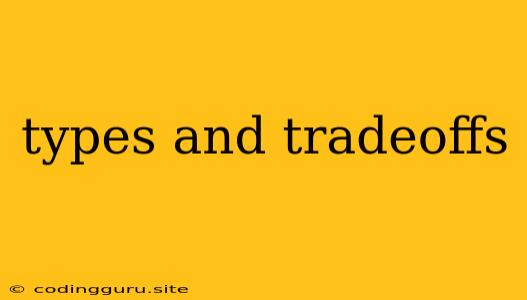Types and Tradeoffs: A Key Concept in Software Development
In the world of software development, we constantly face choices. Whether selecting a programming language, a database, or an architectural pattern, each decision comes with its own set of advantages and disadvantages. Understanding the types and tradeoffs associated with these choices is crucial for making informed decisions and building effective solutions.
This article delves into the concept of types and tradeoffs, exploring how it impacts various aspects of software development. We'll examine why this concept is fundamental to designing and implementing high-quality software.
What are Types and Tradeoffs?
In essence, types and tradeoffs refer to the different options available to developers and their respective strengths and weaknesses. Every decision in software development involves weighing these types and tradeoffs.
For instance, consider the choice between a relational database (RDBMS) and a NoSQL database. An RDBMS offers structured data storage and robust querying capabilities, but may be slower for certain types of operations. A NoSQL database, on the other hand, prioritizes flexibility and scalability, but may lack the query functionality of an RDBMS.
This example illustrates the core principle of types and tradeoffs: choosing one option inevitably involves accepting some compromises.
Why are Types and Tradeoffs Important?
Understanding types and tradeoffs is critical for several reasons:
- Informed Decision Making: By recognizing the types and tradeoffs of different options, developers can make deliberate choices that align with the specific requirements of their projects.
- Optimized Solutions: Choosing the right tools and techniques for the job leads to optimized solutions that are both efficient and effective.
- Avoiding Pitfalls: Being aware of the potential downsides of various choices allows developers to anticipate and mitigate potential problems.
- Flexibility and Adaptability: Understanding types and tradeoffs fosters flexibility and adaptability, allowing developers to adjust their approaches as project requirements evolve.
Common Types and Tradeoffs
The concept of types and tradeoffs applies to various aspects of software development. Here are some common areas where these considerations play a crucial role:
- Programming Languages: Each language offers unique strengths and weaknesses. Some languages are known for their performance (e.g., C++), while others excel in readability (e.g., Python).
- Database Systems: As mentioned earlier, relational databases (RDBMS) and NoSQL databases have different strengths and weaknesses.
- Software Architecture: Different architectural patterns (e.g., microservices, monolithic) have different types and tradeoffs in terms of scalability, maintainability, and complexity.
- Data Structures and Algorithms: Choosing the right data structure and algorithm depends on factors like space complexity, time complexity, and the specific problem being solved.
- Testing Strategies: Various testing approaches (e.g., unit testing, integration testing) have different advantages and disadvantages in terms of coverage, efficiency, and effectiveness.
- Deployment Strategies: Different deployment methods (e.g., continuous integration/continuous deployment (CI/CD)) offer varying levels of automation, speed, and risk.
Examples of Types and Tradeoffs
Let's explore a few specific examples to illustrate the concept of types and tradeoffs in action:
-
Choosing a Programming Language for a Web Application:
- JavaScript: Offers excellent support for front-end development, wide community, and rich ecosystem. However, it can be challenging to debug and maintain complex projects.
- Python: Known for its readability, powerful libraries, and ease of learning. It may not be the most performant choice for highly demanding applications.
- Java: Provides a robust and scalable platform, but can be more verbose and require a steeper learning curve.
-
Selecting a Database for an E-commerce Platform:
- MySQL: A popular RDBMS known for its reliability and performance, but may struggle with handling massive amounts of data.
- MongoDB: A NoSQL database ideal for handling unstructured data and high write throughput, but lacks the robust querying capabilities of an RDBMS.
- Redis: An in-memory data store offering lightning-fast access, but primarily used for caching and session management, not for persistent storage.
-
Deciding on a Software Architecture:
- Microservices: Allows for greater scalability, flexibility, and independent development of components. However, it can increase complexity and make distributed debugging more challenging.
- Monolithic: Provides a simpler development and deployment model, but can limit scalability and make it harder to make changes without affecting the entire system.
Conclusion
The concept of types and tradeoffs is fundamental to software development. It underscores the reality that every decision involves a balance between benefits and drawbacks. By carefully considering these types and tradeoffs, developers can make informed choices that lead to effective, efficient, and adaptable software solutions.
Remember, there is no one-size-fits-all approach. The optimal choice always depends on the specific project requirements, constraints, and priorities. The ability to analyze types and tradeoffs effectively empowers developers to build robust, scalable, and high-quality software.
